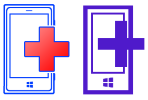
Nokia Corporation is a Finnish multinational telecommunications, information technology, and consumer electronics company, founded in 1865. Nokia's main headquarters are in Espoo, Finland, in the greater Helsinki metropolitan area, but the company's actual roots are in the Tampere region of Pirkanmaa. In 2020, Nokia employed approximately 92,000 people across over 100 countries, did business in more than 130 countries, and reported annual revenues of around €23 billion. Nokia is a public limited company listed on the Helsinki Stock Exchange and New York Stock Exchange. It is the world's 415th-largest company measured by 2016 revenues according to the Fortune Global 500, having peaked at 85th place in 2009. It is a component of the Euro Stoxx 50 stock market index.

Microsoft Software Updater is a Windows and OS X based application launched in 2006, that enables customers to update and recover their mobile device firmware of a S40 or S60 or Lumia device from any Internet enabled access point. To avoid data loss users are prompted with on-screen advice on how to safely update their device.
The Excel/Excell was a range of mobile phones developed by the British company Technophone in the 1980s. These mobile phones were advertised as the smallest, lightest most intelligent mobile phones in the world at that time, and were the first to fit in a pocket. While much larger than later mobile telephones at 7 inches tall, 3 inches wide and 1 inch deep, they were very much more compact than mobiles of their time, which included models by Motorola and Stornophone, and dedicated car phones.

Ovi by Nokia was the brand for Nokia's Internet services. The Ovi services could be used from a mobile device, computer or via the web. Nokia focused on five key service areas: Games, Maps, Media, Messaging and Music. Nokia's aim with Ovi was to include third party developers, such as operators and third-party services like Yahoo's Flickr photo site. With the announcement of Ovi Maps Player API, Nokia started to evolve their services into a platform, enabling third parties to make use of Nokia's Ovi services.
A mobile operating system is an operating system for mobile phones, tablets, smartwatches, 2-in-1 PCs, smart speakers, or other mobile devices. While computers such as typical laptops are 'mobile', the operating systems used on them are generally not considered mobile ones, as they were originally designed for desktop computers that historically did not have or need specific mobile features. This distinction is becoming blurred in some newer operating systems that are hybrids made for both uses.

The Series 30, often shortened as S30, is a software platform and application user interface created by Nokia for its entry level mobile phones, lower than Series 40. S30 phones are not capable of running Java apps. In 2014, Microsoft acquired Nokia's mobile phones business and later discontinued S30 in favor of Series 30+.
A mobile application, also referred to as a mobile app or simply an app, is a computer program or software application designed to run on a mobile device such as a phone, tablet, or watch. Mobile applications often stand in contrast to desktop applications which are designed to run on desktop computers, and web applications which run in mobile web browsers rather than directly on the mobile device.

Microsoft Lumia is a discontinued line of mobile devices that was originally designed and marketed by Nokia and later by Microsoft Mobile. Introduced in November 2011, the line was the result of a long-term partnership between Nokia and Microsoft—as such, Lumia smartphones run on Microsoft software, the Windows Phone operating system; and later the newer Windows 10 Mobile. The Lumia name is derived from the partitive plural form of the Finnish word lumi, meaning "snow".
Microsoft mobile services are a set of proprietary mobile services created specifically for mobile devices, they are typically offered through mobile applications and mobile browser for Windows Phone, | platforms, BREW, and Java. Microsoft's mobile services are typically connected with a Microsoft account and often come preinstalled on Microsoft's own mobile operating systems while they are offered via various means for other platforms. Microsoft started to develop for mobile computing platforms with the launch of Windows CE in 1996 and later added Microsoft's Pocket Office suite to their Handheld PC line of PDAs in April 2000. From December 2014 to June 2015, Microsoft made a number of corporate acquisitions, buying several of the top applications listed in Google Play and the App Store including Acompli, Sunrise Calendar, Datazen, Wunderlist, Echo Notification Lockscreen, and MileIQ.
The Opera Mobile Store is a platform-independent browser-based app store for mobile-phone owners and a digital application distribution platform used by more than 40,000 developers around the world, owned and maintained by Opera Software ASA. Launched and powered by a third-party provider in March, 2011 the Opera Mobile Store was relaunched on a new platform, after acquisition of Handster, a mobile app store platform company, in January 2012. The service allows users to browse and download applications for over 7,500 different devices on Android, Java, BlackBerry OS, Symbian, iOS, and Windows Mobile.

Microsoft Mobile was a subsidiary of Microsoft involved in the development and manufacturing of mobile phones. Based in Espoo, Finland, it was established in 2014 following the acquisition of Nokia's Devices and Services division by Microsoft in a deal valued at €5.4 billion, which was completed in April 2014. Nokia's then-CEO, Stephen Elop, joined Microsoft as president of its Devices division following the acquisition, and the acquisition was part of Steve Ballmer's strategy to turn Microsoft into a "devices and services" company. Under a 10-year licensing agreement, Microsoft Mobile held rights to sell feature phones running the S30+ platform under the Nokia brand.
Android One is a family of third-party Android smartphones promoted by Google. In comparison to many third-party Android devices, which ship with a manufacturer's customized user interface and bundled apps, these devices run near-stock versions of Android with limited modifications, and a focus on Google services. Devices that run Android One receive OS updates for at least two years after their release, and security patches for at least three years.
The Nokia 3-digit series are a series of feature and smartphones by HMD Global and previously by Microsoft Mobile and Nokia, generally aimed at developing markets.

Series 30+ is a software platform and application user interface used for Nokia-branded mobile devices. The platform was introduced by Nokia in September 2013, first appearing on the Nokia 108, and has been the main Nokia feature phone operating system after the end of the Series 30 and Series 40 platforms in 2014. Despite the similar name and user interface, S30+ is technically completely different and unrelated to S30.

Nokia 105 is a mobile phone released in 2013 aimed at markets in developing nations marketed and manufactured by Nokia.

HMD Global Oy, branded as HMD and Nokia Mobile, is a Finnish mobile phone manufacturer. The company is made up of the mobile phone business that Nokia sold to Microsoft in 2014, then bought back in 2016. HMD began marketing Nokia-branded smartphones and feature phones on 1 December 2016. The company has exclusive rights to the Nokia brand for mobile phones through a licensing agreement. The HMD brand is only used for corporate purposes and does not appear in advertising, whereas the name "Nokia Mobile" is used on social media.

Nokia 105 (2017) is a Nokia-branded mobile phone developed by HMD Global. It was released on 17 July 2017 and is available in black, white, and blue. It also has 3 games: Snake Xenzia, Doodle Jump, and Crossy Road. There are some other Nokia 105 units sold in certain regions that also have 3 more games: Ninja Up, Air Strike and Tetris.
Nokia 105 is the name of a series of different mobile phones manufactured and/or marketed by Nokia.










